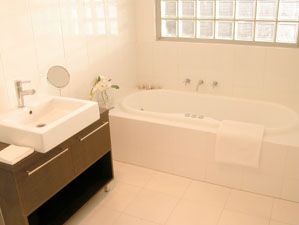
Bathroom flooring is the most crucial aspect of remodeling a bathroom. In fact, many homeowners undertake a remodeling job due to worn or damaged flooring. A flooring not only gives your bathroom an aesthetically pleasing appearance, but it also protects it from water damage. Although, there are a myriad bathroom floor choices, only a handful of them prove to be of practical use. Homeowners can find bathroom flooring options in a wide range of materials in varying price range. However, before you zero in on any one flooring type, it is imperative that you understand the pros and cons of each material.
How to Pick a Bathroom Flooring
The first and the foremost important point to consider while choosing a bathroom flooring is its resistance to water. Bathroom is a place which is subjected to hot and cold water, steam, harsh chemicals from cleansers etc. Hence, the flooring you choose should be able to withstand such extreme temperature variations. Besides, bathroom does not allow enough and proper ventilation, which may give a constricted, dreary appearance to it. The flooring should ideally alleviate or reduce this impact and make the bathroom look cheerful and nice. Also, the damp, wet conditions and lack of enough sunlight gives way to mold and mildew growth. The flooring that you choose for bathroom should be resistant to mold and mildew growth.
Bathroom Flooring Types
As mentioned above, there are numerous options for bathroom flooring. Surprisingly, some people even go for carpet flooring, which sounds like the most inappropriate flooring for bathrooms. Also, some people cannot resist the charm of hardwood flooring. However, hardwood flooring for bathrooms, again, is not a very feasible option. Moisture inside the bathroom can damage your hardwood flooring sooner than expected. If you must, only install hardwood flooring with a waterproof coating on it. This will minimize the damage due to water to some extent. Engineered wood flooring may also serve the purpose to some extent due to the special treatment against water. After considering the pros and cons of all the available flooring options, we could only come up with these three practical solutions.
Ceramic Tiles
Ceramic tiles are by far the best and most economical option of bathroom flooring. They render a very clean and hygienic look to the bathroom. Besides, they are available in such a wide range of patterns, colors and styles that matching them with the rest of bathroom décor is no big deal. Installing them yourself can be a major DIY job, hence it's best to rely on professional help. Although, you may have to bear the installation charges, the end result will be worth your money. Ceramic tiles also last for ages and need little or no maintenance. While opting for ceramic tiles, go for smaller tiles as they offer protection against skidding due to more grout. However, one thing that homeowners should bear in mind is that avoiding same tiles for walls and flooring as it creates a monotonous and boring look. If you must use ceramic tiles for walls, at least make sure you use different colors and patterns for wall and flooring.
Vinyl Flooring
Vinyl is yet another preferable option for bathroom tiles. It can withstand moisture and extreme temperatures and is also easier to clean and maintain. It is available in various colors and textures which resemble wood and stone patterns. One of the biggest advantage of using vinyl is, it is cheap. Also you can install vinyl tiles yourself in a few hours time. However, these tiles also tend to peel off pretty quickly, hence, sheet vinyl might be a better option.
Slate
Stone flooring is one of the most exquisite flooring option we have around. The class, style, elegance of stone is unmatchable. However, it may not be the best flooring option for your bathroom as it is very cold and tends to be slippery when wet. A slate flooring is worth considering if you insist upon stone flooring for your bathroom. Slate is comparatively cheaper than other stone flooring options and prevents skidding to some extent.
Bathroom flooring must be strong, durable and light on maintenance. Besides, it should not cost you a fortune. Considering these factors, you may want to stick to one of the three flooring types mentioned in this article.





